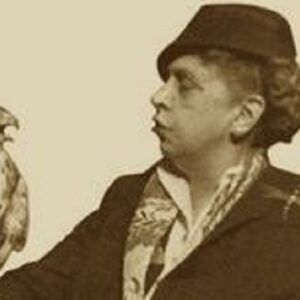American environmentalist and women’s rights advocate Rosalie Edge established the Hawk Mountain Sanctuary in Pennsylvania. Rosalie Edge was the first American woman to win widespread recognition for her work as a conservationist. She was a progressive New York socialite and devoted suffragist. She was born in New York City to affluent parents, enjoyed a privileged upbringing, and attended private schools. She wed a wealthy British engineer and frequently traveled across the Atlantic with him for work, dividing her time between New York and Europe. During one of her journeys, she encountered Lady Rhondda, a women’s suffrage activist, and her life was forever changed. Rosalie was deeply inspired by the encounter and joined the women’s suffrage movement. Later, after returning to the United States, she made a significant contribution to the adoption of the Constitution’s 19th Amendment, which gave women the right to vote. Rosalie then focused on wildlife activism and quickly developed a love for birds. She dedicated her life to conservation and founded the Emergency Conservation Committee, which throughout the years produced numerous brochures to forbid hunting. She raised the worried location when the committee saw images of perishing birds in the Kittatinny Mountains and established the “Hawk Mountain Sanctuary,” serving as its president until her passing. Rosalie was one of the 20th century’s most ardent environmentalists, and her refuge is still in use today for conservation efforts as well as for initiatives in education and research.
Early Childhood & Life
Rosalie Edge was born Mabel Rosalie Barrow on November 3, 1877, in New York City, United States. Her parents were John Wylie Barrow and Harriet Bowen Woodward Barrow, successful British importers, and accountants.
Rosalie was the youngest of her rich family’s five surviving children.
Rosalie Edge attended the exclusive school Miss Doremus’ School for her elementary schooling. She was raised in high society with manners and never went to college.
A Later Years
Rosalie met Sybil Margaret Thomas, well known as Lady Rhondda, a notable British women’s suffrage activist, on one of her transatlantic journeys in 1913. Rosalie learned about the male-dominated political environment that was undermining women’s rights through Sybil. Rosalie was profoundly affected by the encounter, and she chose to join the women’s suffrage campaign almost immediately.
She afterward joined the Equal Franchise Society, picked up some political fundamentals, discovered her speaking talent, and began participating in debates. She was then chosen to serve as the New York State Woman Suffrage Party’s secretary and treasurer.
When she eventually made it back to the country, she started to strongly support women’s equal rights. She made a key contribution to the 1920 adoption of the Nineteenth Amendment to the US Constitution, which granted women the right to vote.
After winning the battle for women’s suffrage, Rosalie focused on protecting wildlife and the environment. Her passion for bird watching led her to collect a list of more than 800 different bird species.
She was given a pamphlet titled “A Crisis in Conservation” in 1929 that discussed the significant problem of hunting. It harshly condemned the National Association of Audubon Societies (NAAS), a group dedicated to wildlife conservation, for inexcusably permitting hunting on its property in Louisiana.
Rosalie then established the Emergency Conservation Committee, which throughout the years printed and disseminated a number of pamphlets that questioned the effectiveness of various purported wildlife conservation organizations.
Rosalie, who founded the organization and has been a member ever since, skillfully argued for the need to implement far tougher safeguards for numerous bird species. As a passionate environmentalist, she also fought for legislation mandating that people safeguard wildlife and the environment.
Rosalie was later moved to tears when she saw pictures of dead hawks in eastern Pennsylvania’s Kittatinny Mountains. Rosalie then started a year-long campaign to raise the $3,500 needed to buy the relevant land in the Pennsylvania mountains close to Kempton.
She eventually acquired the property in 1934, formed the “Hawk Mountain Sanctuary,” and presided over it until her death. She became one of the most well-known names in American conservation over the course of the following three decades as she raised money and ran educational programs in the sanctuary.
She was instrumental in the founding of Yosemite National Park as well as the creation of the Olympic and Kings Canyon National Parks.
Edge’s Bigger Works
Rosalie completely focused her efforts on conservation after helping to secure women’s rights. She opposed the Audubon Societies for their questionable decision to allow hunting on their own property, and she eventually created the Emergency Conservation Committee. Over the years, she published numerous booklets.
Rosalie Edge is most known for creating the “Hawk Mountain Sanctuary,” the first sanctuary for raptors. The eastern Pennsylvania bird sanctuary, founded in 1934, continues to conserve birds, carry out studies, and offer educational programs.
Personal Legacy & Life
Rosalie left for Yokohama, Japan, in May 1909 to wed Charles Noel Edge, a rich British civil engineer who worked on building railroads and ships. Rosalie frequently traveled with Charles during his three-year professional assignment that involved significant travel around Asia. Peter and Margaret were the couple’s two children, and they later made New York their permanent home.
On November 30, 1962, Rosalie Barrow Edge passed away in the Columbia-Presbyterian Medical Center in New York City, United States. Even now, more than 50 years after she passed away, the Hawk Mountain Sanctuary she founded is still doing good work.
Estimated Net Worth
Unknown.


